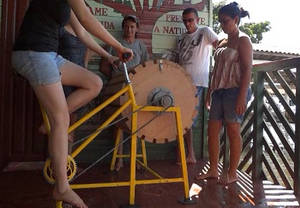A pedal powered cassava peeling machine has been designed to meet the needs of people living in the rural of Amazon region near Manaus, Brazil.
This Master’s Degree Project, carried out by Industrial Design student An Ni Le, was supported by the Innovation Engineering group at the Department of Design Sciences, Lund University, in collaboration with Blekinge Institute of Technology, Sweden and Universidade Federal do Amazonas, Brazil. A one-month fieldtrip was carried out at the rural communities near Manaus, Amazonas, focused on how to support people living in the Amazon region.
Cassava is the sixth most important crop plant, and its flour is a primary calorie source in tropical regions around the world. In the Amazon region, Cassava roots are processed into a type of flour called Farinha, which is extremely common and is used as a basic staple food. The product also provides an important income to huge numbers of households in the rural areas. Transforming cassava into flour is a long process which takes a couple of days and basically includes six steps: Peeling, Washing, Grinding, Drying, Sifting and Frying.
Men usually engage in machine operations for grinding, pressing and sifting, while women and children are usually responsible for any manual operations such as peeling, washing and frying. It has been reported that peeling the roots by hand is a major problem and takes 65% of the total time of the whole process. This hard and tedious job has low productivity and high product losses, and it is very time consuming and requires physical labour in poor working conditions. However, machines for peeling cassava are rare in this region due to the high cost of available machines in the market and the scarcity of electricity.
An Ni Le’s goal in this project was to design and develop a solution for how a low cost product could satisfy the identified needs, thinking about the importance of rural development and poverty alleviation and how small scale productions can contribute to households and livelihood security.
The result is a cassava peeling machine that improves working conditions, increases the productivity, reduces product losses, and reduces time consumption and physical labour. Due to the limit of electricity and high cost of gas, a pedal-powered concept was chosen. The rotating drum efficiently maintains the purpose of rubbing the cassava skin off, using high-tech abrasive rollers with wire brushes.
The testing has showed that the machine has a capacity of peeling 60-100kg/h (compared to 20-35kg/h peeling by hand), with an average flesh loss of 5% (compare to 25% peeling by hand), average peeling efficiency of 95%.Building a machine? If you look at p.178 and onwards in the below document, you will be able to see how to build one. As this is frugal innovation, you can hopefully source the materials locally: http://lup.lub.lu.se/student-papers/record/3357792/file/3567812.pdf There are some people around the world that have built their own machines based on this blueprint, including this one from Brazzaville, Republic of the Congo: https://www.youtube.com/watch?v=sNSA0FvHlQc
For more information


